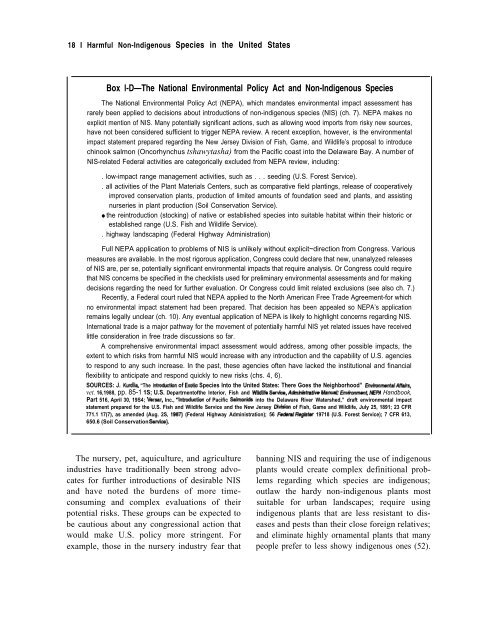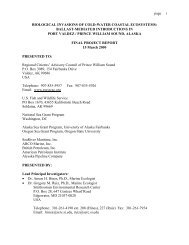Harmful Non-Indigenous Species in the United States - Aquatic ...
Harmful Non-Indigenous Species in the United States - Aquatic ...
Harmful Non-Indigenous Species in the United States - Aquatic ...
You also want an ePaper? Increase the reach of your titles
YUMPU automatically turns print PDFs into web optimized ePapers that Google loves.
18 I <strong>Harmful</strong> <strong>Non</strong>-<strong>Indigenous</strong> <strong>Species</strong> <strong>in</strong> <strong>the</strong> <strong>United</strong> <strong>States</strong>Box l-D—The National Environmental Policy Act and <strong>Non</strong>-<strong>Indigenous</strong> <strong>Species</strong>The National Environmental Policy Act (NEPA), which mandates environmental impact assessment hasrarely been applied to decisions about <strong>in</strong>troductions of non-<strong>in</strong>digenous species (NIS) (ch. 7). NEPA makes noexplicit mention of NIS. Many potentially significant actions, such as allow<strong>in</strong>g wood imports from risky new sources,have not been considered sufficient to trigger NEPA review. A recent exception, however, is <strong>the</strong> environmentalimpact statement prepared regard<strong>in</strong>g <strong>the</strong> New Jersey Division of Fish, Game, and Wildlife’s proposal to <strong>in</strong>troducech<strong>in</strong>ook salmon (Oncorhynchus tshawytasha) from <strong>the</strong> Pacific coast <strong>in</strong>to <strong>the</strong> Delaware Bay. A number ofNIS-related Federal activities are categorically excluded from NEPA review, <strong>in</strong>clud<strong>in</strong>g:. low-impact range management activities, such as . . . seed<strong>in</strong>g (U.S. Forest Service).. all activities of <strong>the</strong> Plant Materials Centers, such as comparative field plant<strong>in</strong>gs, release of cooperativelyimproved conservation plants, production of limited amounts of foundation seed and plants, and assist<strong>in</strong>gnurseries <strong>in</strong> plant production (Soil Conservation Service).● <strong>the</strong> re<strong>in</strong>troduction (stock<strong>in</strong>g) of native or established species <strong>in</strong>to suitable habitat with<strong>in</strong> <strong>the</strong>ir historic orestablished range (U.S. Fish and Wildlife Service).. highway landscap<strong>in</strong>g (Federal Highway Adm<strong>in</strong>istration)Full NEPA application to problems of NIS is unlikely without explicit~direction from Congress. Variousmeasures are available. In <strong>the</strong> most rigorous application, Congress could declare that new, unanalyzed releasesof NIS are, per se, potentially significant environmental impacts that require analysis. Or Congress could requirethat NIS concerns be specified <strong>in</strong> <strong>the</strong> checklists used for prelim<strong>in</strong>ary environmental assessments and for mak<strong>in</strong>gdecisions regard<strong>in</strong>g <strong>the</strong> need for fur<strong>the</strong>r evaluation. Or Congress could limit related exclusions (see also ch. 7.)Recently, a Federal court ruled that NEPA applied to <strong>the</strong> North American Free Trade Agreement-for whichno environmental impact statement had been prepared. That decision has been appealed so NEPA’s applicationrema<strong>in</strong>s legally unclear (ch. 10). Any eventual application of NEPA is likely to highlight concerns regard<strong>in</strong>g NIS.International trade is a major pathway for <strong>the</strong> movement of potentially harmful NIS yet related issues have receivedlittle consideration <strong>in</strong> free trade discussions so far.A comprehensive environmental impact assessment would address, among o<strong>the</strong>r possible impacts, <strong>the</strong>extent to which risks from harmful NIS would <strong>in</strong>crease with any <strong>in</strong>troduction and <strong>the</strong> capability of U.S. agenciesto respond to any such <strong>in</strong>crease. In <strong>the</strong> past, <strong>the</strong>se agencies often have lacked <strong>the</strong> <strong>in</strong>stitutional and f<strong>in</strong>ancialflexibility to anticipate and respond quickly to new risks (chs. 4, 6).SOURCES: J. KurdlltL “The Introcbctbn of Exotk <strong>Species</strong> Into <strong>the</strong> <strong>United</strong> <strong>States</strong>: There Goes <strong>the</strong> Neighborhood” ErMomnerrtslMaks,vet. 16,1988, pp. 85-1 1S; U.S. Departrnentof<strong>the</strong> Interior, Fish and WiktIife Servbe, Adrrh?&trative ManuaL: Gwkonnwnt, hER4 Handbook,Part 516, April 30, 19S4; Veraar, Inc., “lntroduetion of Pacific Salmonida <strong>in</strong>to <strong>the</strong> Delaware River Watershed,” draft environmental impactstatement prepared for <strong>the</strong> U.S. Fish and Wildlife Service and <strong>the</strong> New Jersey DMsion of Fish, Game and Wildlife, July 25, 1891; 23 CFR771.1 17(7), as amended (Aug. 2S, 19S7) (Federal Highway Adm<strong>in</strong>istration); 56 Fe&a/Re@ster 19718 (U.S. Forest Service); 7 CFR 613,650.6 (Soil Conservation Servke).The nursery, pet, aquiculture, and agriculture<strong>in</strong>dustries have traditionally been strong advocatesfor fur<strong>the</strong>r <strong>in</strong>troductions of desirable NISand have noted <strong>the</strong> burdens of more timeconsum<strong>in</strong>gand complex evaluations of <strong>the</strong>irpotential risks. These groups can be expected tobe cautious about any congressional action thatwould make U.S. policy more str<strong>in</strong>gent. Forexample, those <strong>in</strong> <strong>the</strong> nursery <strong>in</strong>dustry fear thatbann<strong>in</strong>g NIS and requir<strong>in</strong>g <strong>the</strong> use of <strong>in</strong>digenousplants would create complex def<strong>in</strong>itional problemsregard<strong>in</strong>g which species are <strong>in</strong>digenous;outlaw <strong>the</strong> hardy non-<strong>in</strong>digenous plants mostsuitable for urban landscapes; require us<strong>in</strong>g<strong>in</strong>digenous plants that are less resistant to diseasesand pests than <strong>the</strong>ir close foreign relatives;and elim<strong>in</strong>ate highly ornamental plants that manypeople prefer to less showy <strong>in</strong>digenous ones (52).














